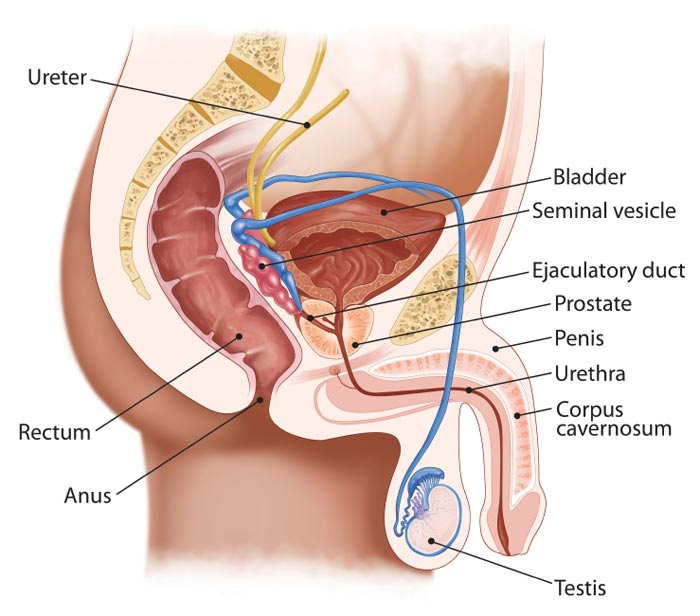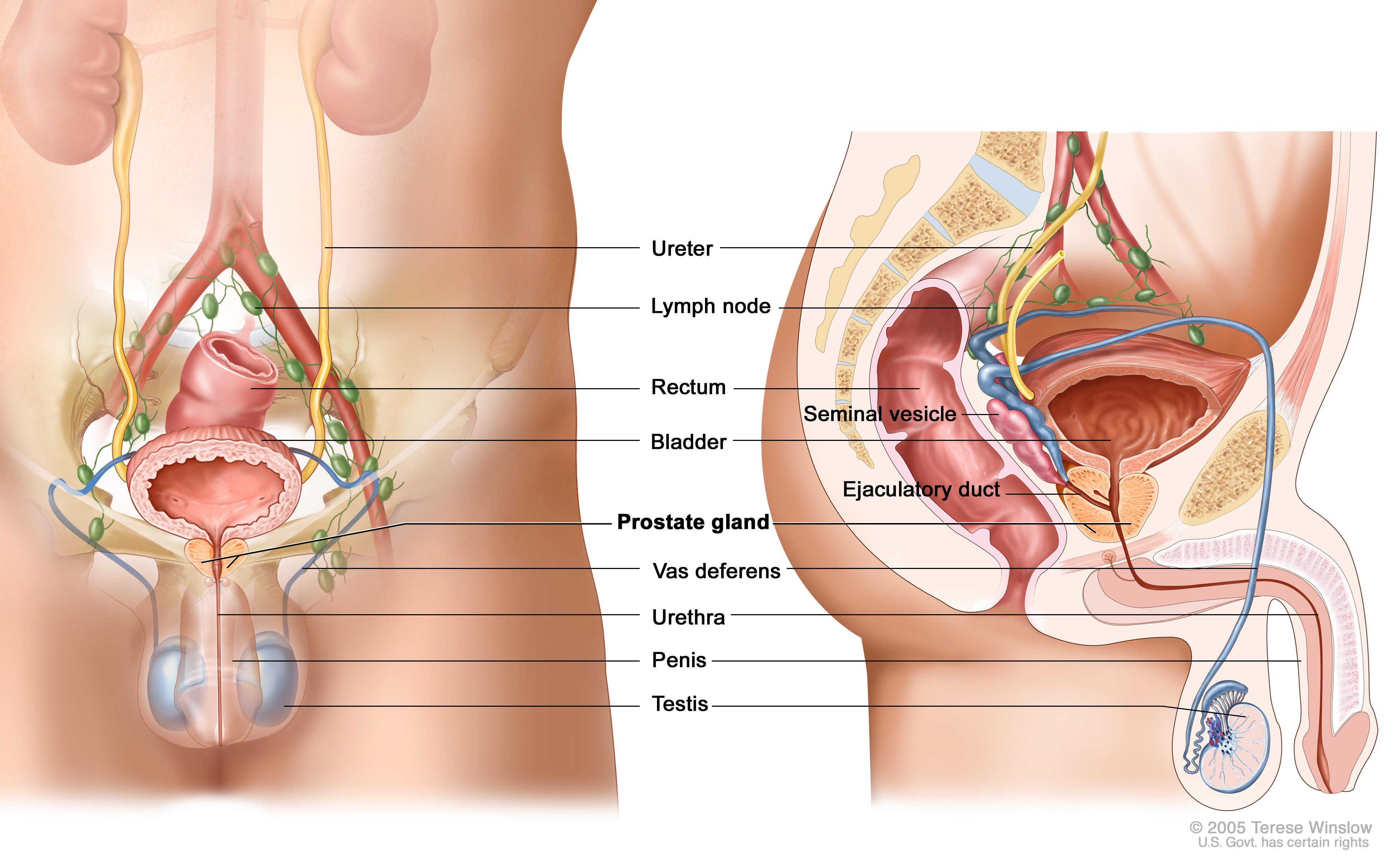Prostate


Prostate
Enlargement of prostate in elderly males
What is the prostate?
The prostate is a small organ about the size of a walnut. It lies below the bladder (where urine is stored) and surrounds the urethra (the tube that carries urine from the bladder). The prostate makes a fluid that helps to nourish sperm as part of the semen (ejaculatory fluid).
What is benign prostatic hyperplasia?
Benign prostatic hyperplasia--also called BPH--is a condition in men in which the prostate gland is enlarged . The exact cause of enlargement is not known, but is related to the levels of the circulating male hormone testosterone.It starts enlarging after 50 years in about 70 per cent of men). This is not cancer or infection.However, BPH and prostate cancer can certainly exist side by side. Also, it is possible for a man diagnosed with BPH to develop prostate cancer at a later date.So it is important for all men over age 50 (or over age 40, for those at higher risk) to have regular checks for prostate cancer as part of their overall wellness plan.
Who is more likely to develop benign prostatic hyperplasia?
Men with the following factors are more likely to develop benign prostatic hyperplasia: - age 40 years and older - family history of benign prostatic hyperplasia - medical conditions such as obesity, heart and circulatory disease, and type 2 diabetes - lack of physical exercise
What are the symptoms of benign prostatic hyperplasia?
- Poor stream. The flow of urine is weaker, and it takes longer to empty your bladder.
- Hesitancy. You may have to wait at the toilet for a while before urine starts to flow.
- Dribbling. Towards the end of passing urine, the flow becomes a slow dribble.
- Poor emptying. You may have a feeling of not quite emptying your bladder.
- Frequency (passing urine more often than normal). This can be most irritating if it happens at night. Getting up several times a night is a common symptom and is called nocturia.
- Urgency. This means you have to get to the toilet quickly when you need to go.
The size of the prostate does not always determine the severity of the blockage or symptoms. Some men with greatly enlarged prostates have little blockage and few symptoms, while other men who have minimally enlarged prostates have greater blockage and more symptoms.
What are the complications of benign prostatic hyperplas
The complications of benign prostatic hyperplasia may include
acute urinary retention (Sometimes men may not know they have a blockage until they cannot urinate) - blood in the urine - urinary tract infections (UTIs) - bladder damage - kidney damage - bladder stones
How is an enlarged prostate diagnosed
it is usually diagnosed by reviewing a patient's medical and family history, asking about symptoms, and conducting a physical exam. Tests used to determine a diagnosis of BPH may include:
Digital rectal exam (helps doctor to determine the size, texture, and shape of prostate and helps rule out prostate cancer). The most objective test is ultrasonography, which gives the size of the prostate, the amount of residual urine in the bladder (i.e. post void residue) and other complications like stone formation and dilatation of the kidneys. Uroflowmetry is another test for objective assessment of patients urine flow. Urine tests (to rule out urinary infection). Prostate-specific antigen test (a test that measures blood levels of PSA, but is unreliable as a definitive screening test). A high test results may suggest the presence of prostate cancer.
How is benign prostatic hyperplasia treated?
Treatment options for benign prostatic hyperplasia may include lifestyle changes medications surgery
Lifestyle Changes
- It is recommend for men whose symptoms are mild or slightly bothersome. Lifestyle changes can include - reducing intake of liquids, particularly before going out in public or before periods of sleep - avoiding or reducing intake of caffeinated beverages and alcohol - avoiding or monitoring the use of certain medications such as for cold and cough which can lead to full blockage of urine. - training the bladder to hold more urine for longer periods - exercising pelvic floor muscles - preventing or treating constipation - stop smoking
Medical Treatments
- The main drugs are alpha blocking agents, which help to reduce the toxicity of the smooth muscle of the prostate and open up the urethral passage for better voiding. - Non-steroidal anti-androgen, which diminishes the effect of the male hormone on the prostate,helps to reduce the size of the prostate if given for a longer time. - It can take six months to experience the full effects of thess drugs - Sometimes, finasteride is used in conjunction with an alpha blocker.
Surgical Treatments
Surgical treatment is indicated when the symptoms are severe and when the complications are manifested.
Surgical treatments for BPH include::
Transurethral resection of the prostate (TURP). Used in 90 percent of all surgeries performed for BPH, TURP involves inserting an instrument called a resectoscope through the urethral opening of the penis and guiding it to the constricted portion of the urethra within the prostate gland.
A wire loop of the resectoscope then cuts the prostate tissue surrounding the urethra and cauterizes the surrounding blood vessels to prevent bleeding. The cut pieces of prostate tissue are carried to the bladder by a controlled water stream and flushed out of the bladder in the final phase of the operation.
Almost 90 percent of individuals who had a TURP have experienced an improvement in the symptoms of BPH.
Open prostatectomy. Open surgery to remove part of the prostate gland is performed when transurethral procedures cannot be used. This form of surgery, which requires an incision in the skin, is necessary if the prostate gland is greatly enlarged, if there are significant complicating factors, or if the muscular wall of the bladder has been significantly damaged and requires repair.
Laser prostatectomy - A laser guided through the urethra produces energy that is directed at the prostate tissue surrounding the constricted portion of the urethra. The laser energy vaporizes the offending prostate tissue
Newer Treatment Option
Prostate laser surgery is used to relieve moderate to severe urinary symptoms caused by an enlarged prostate, a condition known as benign prostatic hyperplasia (BPH).
During prostate laser surgery, your doctor inserts a scope through the tip of your penis into the tube that carries urine from your bladder (urethra). The urethra is surrounded by the prostate. A laser is passed through the scope. The laser delivers energy that is used to shrink or to remove the excess tissue that is blocking the urethra and preventing urine flow.
All lasers use concentrated light to generate precise and intense heat. Laser surgery removes excess prostate tissue by: - Ablation. The laser melts away excess tissue. - Enucleation. The laser cuts away excess prostate tissue.
There are different types of prostate laser surgery, such as:
Photoselective vaporization of the prostate (PVP). A laser is used to melt away (vaporize) excess prostate tissue to enlarge the urinary channel. Holmium laser ablation of the prostate (HoLAP). This is a similar procedure to PVP, except that a different type of laser is used to melt away (vaporize) the excess prostate tissue. Holmium laser enucleation of the prostate (HoLEP). The laser is used to cut and remove the excess tissue that is blocking the urethra. Another instrument, called a morcellator, is then used to chop the prostate tissue into small pieces that are easily removed.The type of laser surgery your doctor will perform depends on several factors, including the size of your prostate, your health, the type of laser equipment available and your doctor's training.





